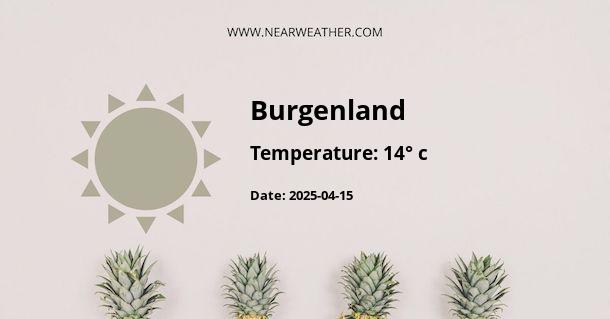Climate and Weather in Burgenland, Austria
Burgenland is a beautiful region located in the eastern part of Austria. It is known for its stunning landscapes, vineyards, and charming villages. The climate in Burgenland is influenced by its geographical location, which results in unique weather patterns throughout the year. Let's explore the climate and weather conditions in Burgenland in more detail.
Geographical Features
Burgenland is characterized by a diverse topography that contributes to its climate. The region is bordered by the Danube River to the north and the Neusiedler See, a large lake, to the east. The lowlands and hills in the west gradually give way to the pannonian plain in the east, creating a varied and interesting landscape.
Temperature
The climate in Burgenland is classified as a continental climate with mild winters and warm summers. The temperature variations between the seasons are quite significant. In winter, temperatures can drop to around freezing or slightly below, while in summer, they can reach highs of around 30°C (86°F).
Here is a table showcasing the average temperatures in Burgenland throughout the year:
| Month | Average Temperature (°C) |
|---|---|
| January | 0.5 |
| February | 2.5 |
| March | 7 |
| April | 12 |
| May | 17 |
| June | 20 |
| July | 22 |
| August | 22 |
| September | 18 |
| October | 12 |
| November | 5 |
| December | 1 |
Precipitation
Burgenland experiences a moderate amount of rainfall throughout the year. The annual precipitation ranges from 500mm to 700mm, with the highest amounts occurring during the summer months. The spring and autumn seasons tend to be relatively drier. The region also benefits from a good number of sunshine hours, especially during the summer.
Wind
Burgenland is not particularly known for strong or persistent winds. However, the region can experience occasional breezes, especially near the Neusiedler See. These breezes can have a cooling effect during the summer months, making the temperatures more bearable.
Climate Variations
Due to its diverse topography, Burgenland experiences some climate variations within the region. The western part, with its higher elevation, tends to have slightly cooler temperatures compared to the eastern part. The Neusiedler See, with its shallow depth, can influence the local climate by moderating temperatures and creating microclimates in the surrounding areas.
Best Time to Visit
The best time to visit Burgenland depends on personal preferences and the activities you plan to engage in. The summer months of June, July, and August offer warm temperatures, making it ideal for outdoor activities like hiking and exploring the vineyards. Spring (April and May) and autumn (September and October) are milder and less crowded, making them a great time to discover the region's natural beauty and enjoy wine tasting.
In conclusion, Burgenland's climate is characterized by mild winters, warm summers, and moderate rainfall throughout the year. The region's diverse topography and proximity to the Neusiedler See contribute to climate variations within the area. Whether you visit in the summer or during the milder seasons, Burgenland offers a pleasant climate for exploring its picturesque landscapes and experiencing its rich cultural heritage.
A - Burgenland's Latitude is 47.500000 & Longitude is 16.416670.
A - Weather in Burgenland is 14° today.
A - Climate Conditions in Burgenland shows overcast clouds today.
A - Humidity in Burgenland is 80% today.
A - Wind speed in Burgenland is 13.1 km/h, flowing at 172° wind direction. today.
